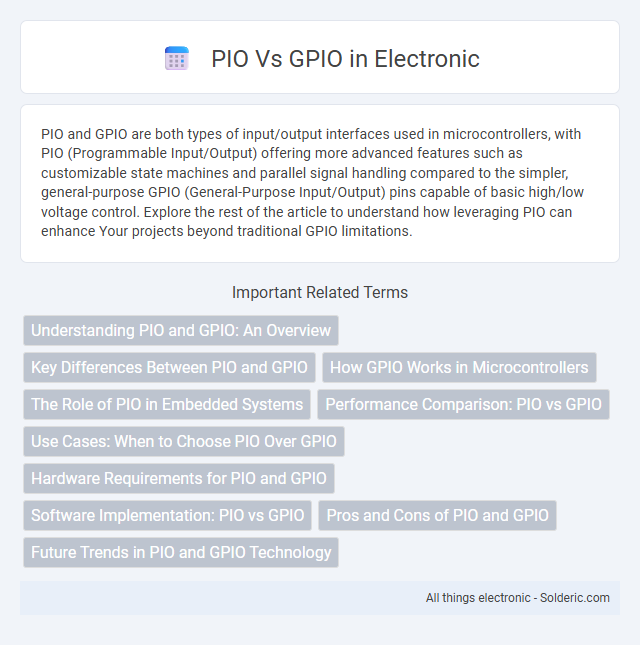PIO and GPIO are both types of input/output interfaces used in microcontrollers, with PIO (Programmable Input/Output) offering more advanced features such as customizable state machines and parallel signal handling compared to the simpler, general-purpose GPIO (General-Purpose Input/Output) pins capable of basic high/low voltage control. Explore the rest of the article to understand how leveraging PIO can enhance Your projects beyond traditional GPIO limitations.
Comparison Table
| Feature | PIO (Parallel Input/Output) | GPIO (General Purpose Input/Output) |
|---|---|---|
| Definition | Parallel data lines for simultaneous multiple bit data transfer | Flexible single pins configurable as input or output |
| Data Transfer | Multiple bits parallel, faster data transfer | Single bit per pin, slower but versatile |
| Typical Use | High-speed data buses, memory interfacing | Control signals, LED control, button input |
| Configurability | Generally fixed functionality for parallel lines | Highly configurable as input/output with pull-up/down |
| Complexity | Requires precise timing and synchronization | Simple and flexible hardware interface |
| Examples | Data buses like 8-bit or 16-bit parallel port | Microcontroller pins like Raspberry Pi GPIO headers |
Understanding PIO and GPIO: An Overview
PIO (Programmable Input/Output) and GPIO (General-Purpose Input/Output) are essential components in microcontroller and embedded system design, enabling digital signal control and communication with external devices. GPIO provides simple, fixed-function pins for input or output operations, while PIO offers a more flexible, programmable interface capable of handling complex I/O tasks through custom state machines. Understanding the distinction between PIO's programmable logic capabilities and GPIO's straightforward digital control is key for optimizing hardware interfaces and enhancing system functionality.
Key Differences Between PIO and GPIO
PIO (Programmable Input/Output) allows complex, programmable control over device pins with user-defined timing and behavior, often supported by dedicated hardware like state machines. GPIO (General Purpose Input/Output) provides simple, direct control over pins for basic digital input and output operations without advanced timing or logic capabilities. Key differences include PIO's flexibility for custom protocols and real-time processing versus GPIO's straightforward, low-latency pin state manipulation.
How GPIO Works in Microcontrollers
GPIO (General Purpose Input/Output) pins in microcontrollers serve as versatile interfaces for digital signals, allowing you to configure them as either inputs or outputs. When set as inputs, GPIO pins detect voltage levels to read sensor data or user inputs, while as outputs, they control devices by sending high or low signals. These pins operate through internal registers that manage direction, state, and interrupts, enabling precise control and monitoring of connected peripherals in embedded systems.
The Role of PIO in Embedded Systems
PIO (Programmable Input/Output) in embedded systems enables flexible control of digital signals by allowing software to configure pin functions dynamically, unlike GPIO (General Purpose Input/Output) which offers fixed basic input/output capabilities. PIO supports complex I/O protocols and timing-sensitive applications by offloading tasks from the main CPU, enhancing performance and responsiveness. This ability makes PIO indispensable for real-time embedded applications requiring precise control over multiple I/O lines.
Performance Comparison: PIO vs GPIO
PIO (Programmable Input/Output) offers higher flexibility and parallel processing capabilities compared to GPIO (General Purpose Input/Output), enabling complex timing-sensitive tasks without CPU intervention. GPIO provides straightforward, low-latency digital signal control but lacks the advanced programmability and offloading potential that PIO achieves. Your choice depends on whether you prioritize raw performance for specific protocols with PIO or simple, direct I/O management using GPIO.
Use Cases: When to Choose PIO Over GPIO
Programmable Input/Output (PIO) excels over General-Purpose Input/Output (GPIO) in use cases requiring complex timing, custom protocols, or simultaneous multi-pin control, such as driving LED matrices, implementing custom communication protocols like SPI or I2C, and precise sensor interfacing in embedded systems. GPIO is best suited for simple on/off control, basic digital input reading, or straightforward peripheral interfacing without the need for detailed timing or sequence control. Choosing PIO is ideal when flexibility and programmability in I/O pin behavior enhance hardware capabilities beyond static GPIO functions.
Hardware Requirements for PIO and GPIO
PIO (Programmable Input/Output) requires specialized microcontroller hardware with dedicated state machines and flexible programmable logic, enabling custom protocol implementation and precise timing control. GPIO (General Purpose Input/Output) relies on simpler pins found on most microcontrollers that support basic digital input and output functions without advanced programmability. Understanding your hardware's capabilities helps determine whether PIO or GPIO best fits your project's complexity and timing requirements.
Software Implementation: PIO vs GPIO
PIO (Programmable Input/Output) offers a flexible software implementation by allowing custom, state-machine-based control over pin behavior, enabling complex I/O protocols without dedicated hardware. GPIO (General-Purpose Input/Output) relies on fixed-function registers for straightforward pin configuration and operation, typically managed by simple read/write commands in software. PIO's programmable nature requires more intricate software coding but provides greater adaptability compared to the more direct, hardware-defined control of GPIO.
Pros and Cons of PIO and GPIO
PIO (Parallel Input/Output) offers high-speed data transfer and simultaneous control over multiple lines, making it ideal for applications requiring fast, parallel data handling. However, PIO demands more pins and complex wiring, increasing hardware complexity and cost. GPIO (General-Purpose Input/Output) provides versatile, programmable control of individual pins, suitable for diverse input/output tasks with lower hardware requirements, but it often operates at slower speeds and handles fewer signals simultaneously.
Future Trends in PIO and GPIO Technology
Future trends in PIO and GPIO technology emphasize increased integration with AI and machine learning for smarter automation and adaptive control systems. Enhanced power efficiency and support for higher data transfer rates will enable more complex and real-time applications in IoT and edge computing. Your designs will benefit from improved flexibility and scalability as advanced PIO and GPIO modules incorporate programmable logic and customizable interfaces.
PIO vs GPIO Infographic

 solderic.com
solderic.com